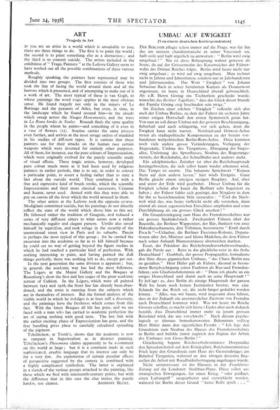ART
_Tragedy in Art
IF you are an artist in a world which is unsuitable to you, there are three things to do. The first is to paint the world ;
the second is to paint something else as a distraction ; and the third is to commit suicide. The artists included in the exhibition of " Tragic Painters " at the Lefevre Gallery seem to have worked out all the possible combinations of these various methods.
Roughly speaking, the painters here represented may be divided into two groups. The first consists of those who took the line of facing the world around them and all the horrors which it presented, and of attempting to make out of it a work of art. The most typical of these is van Gogh, to whose paintings the word tragic applies in the most obvious sense. He found tragedy not only in the miners of Le Borinage and the peasants of Arles, but even, in time, in the landscape which he found around him—in the clouds which sweep across the Nuages Mouvementes, and the trees in La Route bordee de Saules. Rouault finds the same quality in the people whom he paints—and something of it even in a vase of flowers (r5). Soutine carries the same process even further, and arrives at the most savage satires of mankind in his studies of different types. It is curious that these painters use for their attacks on the human race certain weapons which were invented for entirely other purposes. All of them, for instance, use the pure colours of Impressionism, which were originally evolved for the purely scientific study of visual effects. These tragic artists, however, developed pure colour much more as it had been used by religious painters in earlier periods, that is to say, in order to convey a particular point, to assert a feeling rather than to state a fact about the outside world. They combined it with a free and expressive kind of brush stroke, which the scientific Impressionists and their more classical successors, Cezanne and Seurat, never used. Armed with this they were able to put on canvas all the fever which the world aroused in them.
The other artists at the Lefevre took the opposite co-use. Modigliani committed suicide, but his paintings do not directly reflect the state of the world which drove him to this act. He followed rather the tradition of Gauguin, and reduced a series of very different sitters to what seems now a rather mechanically regular and elegant pattern. Utrillo also saved himself by repetition, and took refuge in the security of the unemotional street view in Paris and its suburbs. Pascin is perhaps the most typical of this group ; for he carried the excursion into the academic so far as to kill himself because he could see no way of getting beyond the figure studies in which he had reached a particular kind of perfection. With nothing interesting to paint, and having painted the dull things perfectly, there was nothing left to do, except get out.
In the next generation the same division is apparent ; but, in general, the academic way has had the most followers. The Legers at the Mayor Gallery and the Braques at Rosenberg's show the first and last stages of the great academic retreat of Cubism. In the Legers, which were all painted between 1912 and 1916, the front line has already been aban- doned, and the artist is running from the subjects which are in themselves of interest. But the formal analysis of the visible world in which he indulges is at least still a discovery, and the paintings have the freshness which comes from this fact. With the latest Braques all life has gone, and we are faced with a man vt In has carried to academic perfection the art of saying nothing with good taste. The last link with the earlier exciting phase of Expressionism has gone, and the free handling gives place to carefully calculated spreading of the pigment.
Tchelitchew, at Tooth's, shows that the academic is now as rampant in Superrealism as in abstract painting. Tchelitchew's Phenomena claims apparently to be a comment on the world at large ; but it is a comment made in such sophisticated, erudite language that its interest can only be for a very few. An exploitation of certain peculiar effects of perspective suggested by the camera is combined with a highly complicated symbolism. The latter is explained in a sketch of the various groups attached to the painting, like those which we find with nineteenth-century prints, but with the difference that in this case the clue makes, the puzzle














































 Previous page
Previous page